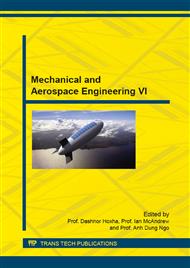[1]
K. Bledzki and J. Gassan, Composites reinforced with cellulose based fibres, Progress in Polymer science, vol. 24 (1999), pp.221-274.
DOI: 10.1016/s0079-6700(98)00018-5
Google Scholar
[2]
R. Kohler and R. W. Kessler, Designing natural fibres for advanced materials, presented at The fifth international conference on woodfibre-plastic composites.
Google Scholar
[3]
D. Nabi Shaeb and J. P. Jog, Natural fiber polymer composites: A review, Advances in Polymer Technology, vol. 18 (1999).
Google Scholar
[4]
J. Denault, Development of Composites based on natural fibers, Biofibers Worshop, Drummondville, Québec, Canada, December 12 (2006).
Google Scholar
[5]
L. Marrot, A. Lefeuvre, B. Pontoire, A. Bournaud, B. Baley, Analysis of the the hemp fiber mechanical properties and their scattering (Fedora 17), Industrial Crops and Products, 51 (2013), pp.317-327.
DOI: 10.1016/j.indcrop.2013.09.026
Google Scholar
[6]
D. Crônier, B. Monties, B. Chabbert, Structure and chemical composition of bast fibersisolated from development hemp stem, Journal of Agricultural and Food Chemistry, 53 (2005), pp.8279-8289.
DOI: 10.1021/jf051253k
Google Scholar
[7]
I. Burgert, Exploring the micromechanical design of plant cell walls, Am. J. Bot., 93 (10), (2006), pp.1391-1401.
DOI: 10.3732/ajb.93.10.1391
Google Scholar
[8]
C. Baley, Analysis of the flax fibres tensile behaviour and analysis of the tensile stiffness increase, Compos. Part A: Appl. Sc. Manuf., 33 (7), (2002), pp.939-948.
DOI: 10.1016/s1359-835x(02)00040-4
Google Scholar
[9]
Karine Charlet et als., Relation between the Microstructure and the Mechanical Behaviour of a Flax Fibre, Laboratoire de Cristallographie et Sciences des matériaux, Laboratoire de cristallographie et science des Matériaux , Ensicaen, E-mail: karine. charlet@ensicaen. fr.
DOI: 10.3166/rcma.18.157-162
Google Scholar
[10]
A. Shahdzad, Effects of Water Absorption on Mecahnical Properties of Hem Fiber Composites, Polymer Composites, (2012), pp.120-128.
Google Scholar
[11]
V. Placet, Characterization of the thermo-mechanical behaviour of Hemp fibres intended for the manufacturing of high performance composites, Composites: Part A 40 (2009), pp.1111-1118.
DOI: 10.1016/j.compositesa.2009.04.031
Google Scholar
[12]
V. Placet, O. Cisse, M. L. Boubakar, Influence of environmental relative humidity on the tensile and rotational behaviour of hemp fibres, J. Mater. Sc. 47, (2012), pp.3435-3446.
DOI: 10.1007/s10853-011-6191-3
Google Scholar
[13]
T. N. Ho and A. D. Ngo, Influence of Temperature and Humidity on the Tensile Strength and Stiffness of hemp anf Coir Fibers, presented at The Fifth Canadian International Composites Conference (CANCOM 2005), Vancouver, Canada.
Google Scholar
[14]
T. N. HO and A. D. NGO, Moisture Sorption of Hemp and Coir Fibres at Various Temperatures., presented at Progress in Wood & Bio-fibre Plastic Composites 2006 International Conference, Toronto.
Google Scholar
[15]
T. N. HO and A. D. NGO, Water sorption at various temperatures of hemp and coir fibre, in 8th International Conference on WoodFiber-Plastic and other natural fibers Composites, Winsconsin, USA, (2005).
Google Scholar
[16]
T.T.N. HO, Étude de l'influence de la temperature et de l'humidité sur les propriétés mécaniques en traction des fibres de chanvre et de coco, Ph.D. thesis, École de technologie supérieure (U. du Québec), Québec, Canada, (2008).
DOI: 10.3166/rcma.18.215-220
Google Scholar
[17]
HO, T.N., NGO, A.D., Hygrothermal Effects on the Tensile Mechanical Properties of Hemp and Coir Fibers, The Proceeding of the American Society of Composites-Twenty Fourth Technical Conference with The Canadian Association for Composite Structure and Materials (Joint Canadian-American International Conference), John W. Gillespie and Suong V. Hoa Eds, September 2009, ISBN: 978-1-60595-008-2. Paper #180.
Google Scholar
[18]
K. Sefroui Manar, Étude des propriétés mécaniques de la fibre de chanvre a fin de connaître sa résistance en fatigue dans l'air et dans l'eau, M. Eng. project report, École de technologie supérieure (U. du Québec), Québec, Canada, (2014).
DOI: 10.4095/297473
Google Scholar
[19]
V. Placet, A. Bouali and P. Perré, The possible role of microfibril angle of Hemp fibre during fatigue test and its determination using Wide-Angle X-ray diffraction, Matériaux & Techniques 99, (2011), pp.683-689.
DOI: 10.1051/mattech/2011120
Google Scholar


